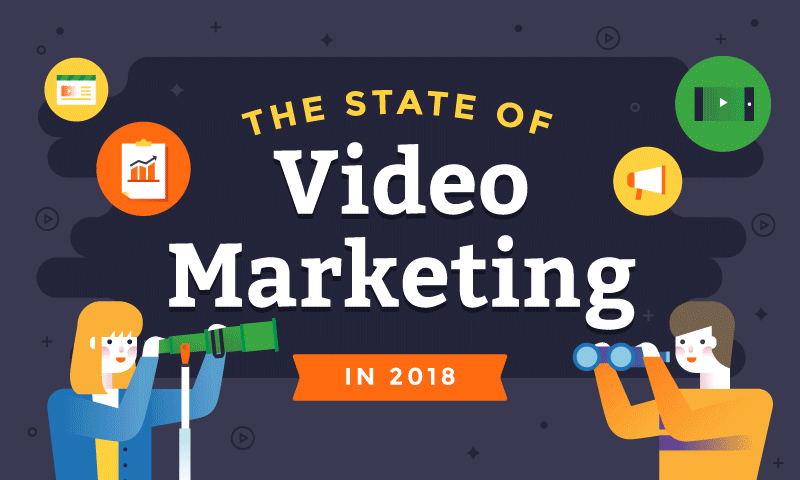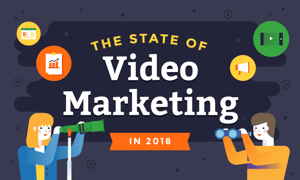
[Infographic] What's in Store for Video Marketing in 2018?
 The year 2017 was exciting for businesses:Demand for video content saw significant growth in the marketing industry. There’s a lot of anticipation and expectation as to how the video marketing field will evolve as 2018 progresses.
The year 2017 was exciting for businesses:Demand for video content saw significant growth in the marketing industry. There’s a lot of anticipation and expectation as to how the video marketing field will evolve as 2018 progresses.
As more and more people flock to a variety of social media platforms, and as those platforms evolve, so too does video marketing need to evolve to continue to be relevant in the digital age.
To prepare your company’s video marketing strategy, here are a series of trends to expect for video marketing in 2018, both in general and across a variety of social media platforms including Facebook, Instagram, Twitter, YouTube, and LinkedIn.
General Video Marketing
In general, content marketing is going to become a lot more personal and original because customers are gravitating to companies that create custom and individualized content. Sixty-one percent of customers said they rely on companies that individualize their content and are more likely to return for future purchases.
Live video is going to become a lot more familiar in 2018, as 82 percent of consumers surveyed said they preferred live video over any other type of social post. It’s already been proven that video posts receive 12 times as many shares and that people retain up to 95 percent of a video message rather than the 10 percent when it comes to text.
As 2018 continues, you can expect to see the spend on social media advertising to rise (Facebook spending alone rose 74 percent in 2017); short-lived video content (like Snapchat) to become a lot more popular; mobile optimization to become the demand and norm; and bite-sized video content to be consumed more frequently.
Facebook Video Marketing
A big evolution to hit Facebook marketing in 2018 is the use of the Facebook creator app—an app that allows creators to make videos, go live with features, and connect to their communities all in a one-stop shop on Facebook. This will cause brands and entrepreneurs to share more stories through live broadcasts, with a higher level of quality and production.
Square video will remain the dominant shape of video (with letterboxing and captioning being the two most common ways to achieve this effect).
Facebook is also going to become a cleaner place to advertise; it is dedicating itself to upholding its community standards and will expect advertisers to do the same. Brands will be able to see the benefit of their ads across TV and Facebook with Cross-Platform Brand Life. Video clickbait content is on the decline with Facebook committing to limit the spread of stories that feature fake video play buttons or static images.
Instagram Video Marketing
Instagram engages many users regularly with its Weekend Hashtag Projects, which encourage people to share their perspectives by including a global hashtag on photos and videos; expect brands to start participating in these projects when they realize their markets are gathering every weekend on #WHP. (Brands will also start and continue branding their engagement through campaign-specific hashtags.)
Instagram’s target audience is also starting to expand. Where it was previously dominated by the 18–29 demographic, as of 2017, these numbers have shifted to include 33 percent in the 30–49 range, 18 percent in the 50–64 range, and even 8 percent of people 65+!
If you’re thinking about getting your company on Instagram—which you should!—you’ll need to consider your aesthetic. Random photos, though perhaps interesting, do not work to remind people of your brand. Your plans need to consider how to create effective Instagram content while also achieving your marketing needs.
Twitter Video Marketing
Twitter users tend to get their news from the social media platform, with 75 percent of those saying they do so every day, and 64 percent also share news through their personal feeds. This isn’t going to change in 2018 nor will live streaming big milestones or TV events, even on a weekly basis; Thursday Night Football streams reach more than 3 million viewers regularly.
What will change is promoted videos become a mainstream choice for brands, as they have proven to increase brand recollection in users and promote purchase intent.
The majority of video content posted to Twitter will be optimized for and uploaded from mobile devices; 90 percent of Twitter video views happen through mobile devices. If you’re looking to increase your Twitter game in 2018, you’re going to have to include animated GIFs if you want your likes, replies, and retweets to increase).
YouTube Video Marketing
A big evolution of video marketing through YouTube will involve partnerships between companies and top YouTube creators; YouTube reaches more 18 to 49 yearolds than cable networks. The rise of YouTube TV will also provide marketers with a larger reach, as the new app will allow users to stream live TV on a variety of Android devices and the Xbox One family.
As YouTube improves its mobile sharing option, marketers will need to ensure their marketing plans include engaging content worthy of being shared. As YouTube holds on to people’s attention with space for chats, replies, and conversation, leveraging this access through YouTube will become ever more important. This is likely to take the form of vlogging-style channels and a focus on relationship building (instead of click-through rates and downloads).
Finally, since YouTube’s previous update brought vertical video to the platform, expect to see more and more brands creating vertical ads (and make sure that your videos are properly optimized for it).
LinkedIn Video Marketing
Though the rollout is slow, LinkedIn is introducing the ability to natively upload video to personal profiles, which means business pages and ads probably aren’t far behind. As this improves, linked videos from other platforms will start to decrease, meaning less linking from Facebook and YouTube, with content being at home directly on LinkedIn. This decreases the need to open videos in a new window (a death sentence to online content), meaning people will be more likely to watch videos on the platform.
B2B business is going to start to boom through LinkedIn. Explainer videos are essential to introducing new products, and with the platform mainly being made up of businesses and professionals, this will make it a ripe place for these kinds of videos to support the networks of B2B business.
As with other platforms, LinkedIn will be optimizing its video content for mobile viewing. People just aren’t using desktops like they used to. The main form of internet access is through a cell phone, and as the demand for video continues to increase, so will the need for all platforms to be mobile friendly.
These are some of the trends you can expect to see for video marketing throughout 2018. As social media platforms like Facebook, Instagram, Twitter, YouTube, and LinkedIn continue to evolve, the power and reach of video marketing will, too. Your company needs to be ready to engage with users through video content, as that is the kind of content they want and share. Your 2018 content strategy should not only include video marketing but ensure it’s a key component.


CEO and Chief Revenue Scientist
Mike Lieberman, CEO and Chief Revenue Scientist
Eliminate Hit-or-Miss Marketing Moves
Get advice, tips, tools and guidance to generate more leads for your company in this weekly email newsletter.



Eliminate Hit-or-Miss Marketing Moves
Get advice, tips, tools and guidance to generate more leads for your company in this weekly email newsletter.













